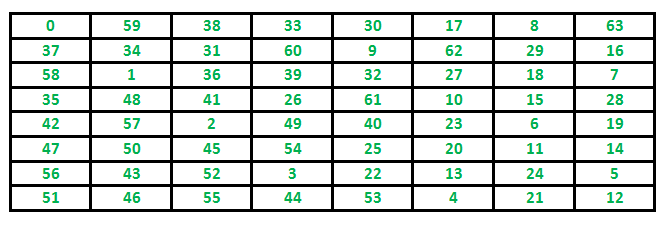مساله سفر اسب — به زبان ساده

در این مطلب، روش حل مساله سفر اسب بیان و پیادهسازی راهکار ارائه شده، در زبانهای برنامهنویسی گوناگون انجام شده است. «پسگرد» (Backtracking) یک پارادایم الگوریتم است که راهکارهای مختلف را تا هنگامی امتحان میکند که راه حل مساله پیدا شود. مسائلی که با استفاده از روشهای پسگرد حل میشوند، دارای خصوصیات مشابهی هستند که در ادامه بیان شده است. این مسائل تنها با آزمودن کلیه پیکربندیهای ممکن، قابل حل هستند و هر پیکربندی تنها یکبار بررسی میشود. یک راهکار ساده برای این مساله، آزمودن همه پیکربندیها و خروجی دادن پیکربندی است که از محدودیتهای مسأله داده شده پیروی میکند.
پسگرد به شیوه افزایشی کار میکند و یک بهینهسازی برای راهکار ساده (Naive Solution) است که همه پیکربندیهای ممکن را تولید و بررسی میکند. برای مثال، میتوان مساله سفر اسب را در نظر گرفت. اسب در اولین بلوک از یک تخته خالی قرار میگیرد و بر اساس قوانین شطرنج باید از هر خانه فقط و فقط یکبار عبور کند. در ادامه، یک صفحه شطرنج ۸×۸ نشان داده شده است. اعداد داخل سلولها نشانگر شماره سفر اسب هستند.

ابتدا باید الگوریتم ساده و سپس الگوریتم پسگرد برای حل این مساله بررسی شود.
الگوریتم ساده برای مساله سفر اسب
در الگوریتم ساده، همه سفرها یکی یکی ساخته و از این جهت بررسی میشوند که آیا محدودیتها را ارضا میکنند یا خیر.
while there are untried tours
{
generate the next tour
if this tour covers all squares
{
print this path;
}
}
الگوریتم پسگرد برای مساله سفر اسب
الگوریتم پسگرد با به کارگیری یک راهکار افزایشی، اقدام به حل مساله سفر اسب میکند. به طور متداول، کار از یک بردار خالی آغاز میشود و عناصر یکی یکی اضافه میشوند. بدین معنا که عناصر از مسالهای به مساله دیگر متفاوت هستند. در مساله سفر اسب، حرکت اسب یک عنصر است.
هنگامی که یک عنصر اضافه میشود، بررسی خواهد شد که آیا عنصر کنونی محدودیتهای مساله را نقض میکند؟ اگر عنصر محدودیتهای مساله را نقض کند، این عنصر حذف و جایگزین دیگری آزموده میشود. اگر هیچ یک از جایگزینها کار نکردند، به گام پیشین رفته و عنصر اضافه شده در گام پیشین حذف میشود. اگر بازگشت به مرحله اول انجام شد، بدین معنا است که هیچ راه حلی وجود ندارد. اگر اضافه کردن یک عنصر محدودیتها را نقض نکند، عناصر به صورت بازگشتی یکی یکی اضافه میشوند. اگر بردار ویژگی کامل شد، راهکار در خروجی چاپ میشود.
الگوریتم پسگرد برای مساله سفر اسب
در ادامه، الگوریتم پسگرد برای مساله سفر اسب آورده شده است.
If all squares are visited print the solution Else a) Add one of the next moves to solution vector and recursively check if this move leads to a solution. (A Knight can make maximum eight moves. We choose one of the 8 moves in this step). b) If the move chosen in the above step doesn't lead to a solution then remove this move from the solution vector and try other alternative moves. c) If none of the alternatives work then return false (Returning false will remove the previously added item in recursion and if false is returned by the initial call of recursion then "no solution exists" )
در ادامه، پیادهسازی راهکار مسأله سفر اسب ارائه شده است. این برنامه یکی از راه حلهای ممکن مسأله را در شکل یک ماتریس دوبُعدی چاپ میکند. اساسا، خروجی یک ماتریس دوبُعدی و ۸×۸ با اعدادی از ۰ تا ۳۶ است و این اعداد گامهای برداشته شده توسط اسب را نشان میدهند.
برنامه حل مساله سفر اسب در C
1// C program for Knight Tour problem
2#include<stdio.h>
3#define N 8
4
5int solveKTUtil(int x, int y, int movei, int sol[N][N],
6 int xMove[], int yMove[]);
7
8/* A utility function to check if i,j are valid indexes
9 for N*N chessboard */
10bool isSafe(int x, int y, int sol[N][N])
11{
12 return ( x >= 0 && x < N && y >= 0 &&
13 y < N && sol[x][y] == -1);
14}
15
16/* A utility function to print solution matrix sol[N][N] */
17void printSolution(int sol[N][N])
18{
19 for (int x = 0; x < N; x++)
20 {
21 for (int y = 0; y < N; y++)
22 printf(" %2d ", sol[x][y]);
23 printf("\n");
24 }
25}
26
27/* This function solves the Knight Tour problem using
28 Backtracking. This function mainly uses solveKTUtil()
29 to solve the problem. It returns false if no complete
30 tour is possible, otherwise return true and prints the
31 tour.
32 Please note that there may be more than one solutions,
33 this function prints one of the feasible solutions. */
34bool solveKT()
35{
36 int sol[N][N];
37
38 /* Initialization of solution matrix */
39 for (int x = 0; x < N; x++)
40 for (int y = 0; y < N; y++)
41 sol[x][y] = -1;
42
43 /* xMove[] and yMove[] define next move of Knight.
44 xMove[] is for next value of x coordinate
45 yMove[] is for next value of y coordinate */
46 int xMove[8] = { 2, 1, -1, -2, -2, -1, 1, 2 };
47 int yMove[8] = { 1, 2, 2, 1, -1, -2, -2, -1 };
48
49 // Since the Knight is initially at the first block
50 sol[0][0] = 0;
51
52 /* Start from 0,0 and explore all tours using
53 solveKTUtil() */
54 if (solveKTUtil(0, 0, 1, sol, xMove, yMove) == false)
55 {
56 printf("Solution does not exist");
57 return false;
58 }
59 else
60 printSolution(sol);
61
62 return true;
63}
64
65/* A recursive utility function to solve Knight Tour
66 problem */
67int solveKTUtil(int x, int y, int movei, int sol[N][N],
68 int xMove[N], int yMove[N])
69{
70 int k, next_x, next_y;
71 if (movei == N*N)
72 return true;
73
74 /* Try all next moves from the current coordinate x, y */
75 for (k = 0; k < 8; k++)
76 {
77 next_x = x + xMove[k];
78 next_y = y + yMove[k];
79 if (isSafe(next_x, next_y, sol))
80 {
81 sol[next_x][next_y] = movei;
82 if (solveKTUtil(next_x, next_y, movei+1, sol,
83 xMove, yMove) == true)
84 return true;
85 else
86 sol[next_x][next_y] = -1;// backtracking
87 }
88 }
89
90 return false;
91}
92
93/* Driver program to test above functions */
94int main()
95{
96 solveKT();
97 return 0;برنامه حل مساله سفر اسب در جاوا
1// Java program for Knight Tour problem
2class KnightTour {
3 static int N = 8;
4
5 /* A utility function to check if i,j are
6 valid indexes for N*N chessboard */
7 static boolean isSafe(int x, int y, int sol[][]) {
8 return (x >= 0 && x < N && y >= 0 &&
9 y < N && sol[x][y] == -1);
10 }
11
12 /* A utility function to print solution
13 matrix sol[N][N] */
14 static void printSolution(int sol[][]) {
15 for (int x = 0; x < N; x++) {
16 for (int y = 0; y < N; y++)
17 System.out.print(sol[x][y] + " ");
18 System.out.println();
19 }
20 }
21
22 /* This function solves the Knight Tour problem
23 using Backtracking. This function mainly
24 uses solveKTUtil() to solve the problem. It
25 returns false if no complete tour is possible,
26 otherwise return true and prints the tour.
27 Please note that there may be more than one
28 solutions, this function prints one of the
29 feasible solutions. */
30 static boolean solveKT() {
31 int sol[][] = new int[8][8];
32
33 /* Initialization of solution matrix */
34 for (int x = 0; x < N; x++)
35 for (int y = 0; y < N; y++)
36 sol[x][y] = -1;
37
38 /* xMove[] and yMove[] define next move of Knight.
39 xMove[] is for next value of x coordinate
40 yMove[] is for next value of y coordinate */
41 int xMove[] = {2, 1, -1, -2, -2, -1, 1, 2};
42 int yMove[] = {1, 2, 2, 1, -1, -2, -2, -1};
43
44 // Since the Knight is initially at the first block
45 sol[0][0] = 0;
46
47 /* Start from 0,0 and explore all tours using
48 solveKTUtil() */
49 if (!solveKTUtil(0, 0, 1, sol, xMove, yMove)) {
50 System.out.println("Solution does not exist");
51 return false;
52 } else
53 printSolution(sol);
54
55 return true;
56 }
57
58 /* A recursive utility function to solve Knight
59 Tour problem */
60 static boolean solveKTUtil(int x, int y, int movei,
61 int sol[][], int xMove[],
62 int yMove[]) {
63 int k, next_x, next_y;
64 if (movei == N * N)
65 return true;
66
67 /* Try all next moves from the current coordinate
68 x, y */
69 for (k = 0; k < 8; k++) {
70 next_x = x + xMove[k];
71 next_y = y + yMove[k];
72 if (isSafe(next_x, next_y, sol)) {
73 sol[next_x][next_y] = movei;
74 if (solveKTUtil(next_x, next_y, movei + 1,
75 sol, xMove, yMove))
76 return true;
77 else
78 sol[next_x][next_y] = -1;// backtracking
79 }
80 }
81
82 return false;
83 }
84
85 /* Driver program to test above functions */
86 public static void main(String args[]) {
87 solveKT();
88 }
89}
90// This code is contributed by Abhishek Shankhadhar برنامه حل مساله سفر اسب در #C
1// C# program for
2// Knight Tour problem
3using System;
4
5class GFG
6{
7 static int N = 8;
8
9 /* A utility function to
10 check if i,j are valid
11 indexes for N*N chessboard */
12 static bool isSafe(int x, int y,
13 int[,] sol)
14 {
15 return (x >= 0 && x < N &&
16 y >= 0 && y < N &&
17 sol[x, y] == -1);
18 }
19
20 /* A utility function to
21 print solution matrix sol[N][N] */
22 static void printSolution(int[,] sol)
23 {
24 for (int x = 0; x < N; x++)
25 {
26 for (int y = 0; y < N; y++)
27 Console.Write(sol[x, y] + " ");
28 Console.WriteLine();
29 }
30 }
31
32 /* This function solves the
33 Knight Tour problem using
34 Backtracking. This function
35 mainly uses solveKTUtil() to
36 solve the problem. It returns
37 false if no complete tour is
38 possible, otherwise return true
39 and prints the tour. Please note
40 that there may be more than one
41 solutions, this function prints
42 one of the feasible solutions. */
43 static bool solveKT()
44 {
45 int[,] sol = new int[8, 8];
46
47 /* Initialization of
48 solution matrix */
49 for (int x = 0; x < N; x++)
50 for (int y = 0; y < N; y++)
51 sol[x, y] = -1;
52
53 /* xMove[] and yMove[] define
54 next move of Knight.
55 xMove[] is for next
56 value of x coordinate
57 yMove[] is for next
58 value of y coordinate */
59 int[] xMove = {2, 1, -1, -2,
60 -2, -1, 1, 2};
61 int[] yMove = {1, 2, 2, 1,
62 -1, -2, -2, -1};
63
64 // Since the Knight is
65 // initially at the first block
66 sol[0, 0] = 0;
67
68 /* Start from 0,0 and explore
69 all tours using solveKTUtil() */
70 if (!solveKTUtil(0, 0, 1, sol,
71 xMove, yMove))
72 {
73 Console.WriteLine("Solution does "+
74 "not exist");
75 return false;
76 }
77 else
78 printSolution(sol);
79
80 return true;
81 }
82
83 /* A recursive utility function
84 to solve Knight Tour problem */
85 static bool solveKTUtil(int x, int y, int movei,
86 int[,] sol, int[] xMove,
87 int[] yMove)
88 {
89 int k, next_x, next_y;
90 if (movei == N * N)
91 return true;
92
93 /* Try all next moves from
94 the current coordinate x, y */
95 for (k = 0; k < 8; k++)
96 {
97 next_x = x + xMove[k];
98 next_y = y + yMove[k];
99 if (isSafe(next_x, next_y, sol))
100 {
101 sol[next_x,next_y] = movei;
102 if (solveKTUtil(next_x, next_y, movei +
103 1, sol, xMove, yMove))
104 return true;
105 else
106 // backtracking
107 sol[next_x,next_y] = -1;
108 }
109 }
110
111 return false;
112 }
113
114 // Driver Code
115 public static void Main()
116 {
117 solveKT();
118 }
119}
120
121// This code is contributed by mits. برنامه حل مساله سفر اسب در پایتون
1# Python3 program to solve Knight Tour problem using Backtracking
2
3# Chessboard Size
4n = 8
5
6def isSafe(x,y,board):
7 '''
8 A utility function to check if i,j are valid indexes
9 for N*N chessboard
10 '''
11 if(x >= 0 and y >= 0 and x < n and y < n and board[x][y] == -1):
12 return True
13 return False
14
15def printSolution(board):
16 '''
17 A utility function to print Chessboard matrix
18 '''
19 for i in range(n):
20 for j in range(n):
21 print(board[i][j],end =' ')
22 print()
23
24
25def solveKT():
26 '''
27 This function solves the Knight Tour problem using
28 Backtracking. This function mainly uses solveKTUtil()
29 to solve the problem. It returns false if no complete
30 tour is possible, otherwise return true and prints the
31 tour.
32 Please note that there may be more than one solutions,
33 this function prints one of the feasible solutions.
34 '''
35
36 # Initialization of Board matrix
37 board = [[-1 for i in range(n)]for i in range(n)]
38
39 # move_x and move_y define next move of Knight.
40 # move_x is for next value of x coordinate
41 # move_y is for next value of y coordinate
42 move_x = [2, 1, -1, -2, -2, -1, 1, 2]
43 move_y = [1, 2, 2, 1, -1, -2, -2, -1]
44
45 # Since the Knight is initially at the first block
46 board[0][0] = 0
47
48 # Step counter for knight's position
49 pos = 1
50
51 # Checking if solution exists or not
52 if(not solveKTUtil(board, 0, 0, move_x, move_y, pos)):
53 print("Solution does not exist")
54 else:
55 printSolution(board)
56
57def solveKTUtil(board,curr_x,curr_y,move_x,move_y,pos):
58 '''
59 A recursive utility function to solve Knight Tour
60 problem
61 '''
62
63 if(pos == n**2):
64 return True
65
66 # Try all next moves from the current coordinate x, y
67 for i in range(8):
68 new_x = curr_x + move_x[i]
69 new_y = curr_y + move_y[i]
70 if(isSafe(new_x,new_y,board)):
71 board[new_x][new_y] = pos
72 if(solveKTUtil(board,new_x,new_y,move_x,move_y,pos+1)):
73 return True
74
75 # Backtracking
76 board[new_x][new_y] = -1
77 return False
78
79# Driver program to test above function
80if __name__ == "__main__":
81 solveKT()
82
83# This code is contributed by AAKASH PALخروجی قطعه کدهای بالا به صورت زیر است.
0 59 38 33 30 17 8 63 37 34 31 60 9 62 29 16 58 1 36 39 32 27 18 7 35 48 41 26 61 10 15 28 42 57 2 49 40 23 6 19 47 50 45 54 25 20 11 14 56 43 52 3 22 13 24 5 51 46 55 44 53 4 21 12
شایان توجه است که روش پسگرد، بهترین راهکار برای حل مساله سفر اسب نیست و الگوریتمهای دیگری وجود دارند که در این مساله، دارای عملکرد بهتری هستند.
اگر نوشته بالا برای شما مفید بوده است، آموزشهای زیر نیز به شما پیشنهاد میشوند:
- مجموعه آموزشهای برنامهنویسی
- آموزش ساختمان دادهها
- مجموعه آموزشهای ساختمان داده و طراحی الگوریتم
- برنامه بررسی وجود دور در گراف بدون جهت — راهنمای کاربردی
- برنامه تشخیص وجود دور در گراف جهتدار — راهنمای کاربردی
- رنگآمیزی گراف به روش حریصانه — به زبان ساده
^^













مثل همیشه عالی